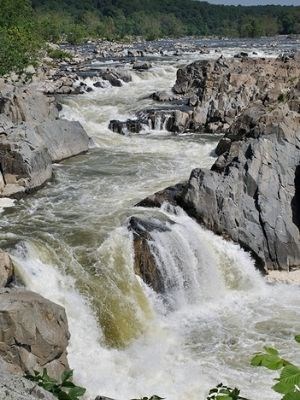Part of a series of articles titled The Power of Water.
Article
The Power of Water: Creating Energy

NPS Photo / Dale Pate
Creating Energy
By Raisa Barrera
Have you ever been to beach and watch the waves crash? Ever visit Great Falls and hear and see the rushing water goes tumble down the rocks? How about turn on your sink and rinse away the soap off your hands? Then you've seen water create energy before! In this NPS article series, you will answer the following questions:
- How does water create energy?
- How does the Potomac River create energy?
- Where are examples of water creating energy throughout the C&O Canal?
Water is all around us! Water is in our homes, comes rushing down when it rains, and even a major part of our National Parks. Together, let's learn how water creates energy.
How does water create energy?
Energy from moving water can be used to create electricity in several different ways: a hydroelectric dam, wave power, or tidal power.
-
Hydroelectric dam: Takes energy from a moving river. The dam controls the flow of water and the amount of electricity that is produced. Dams create large bodies of calm water (or reservoirs) behind them. These bodies of waters can be used for recreation, wildlife sanctuaries, or even sources of drinking water.
-
Wave power: Takes energy from waves on the surface of the ocean using technology like a special buoy or other floating device.
-
Tidal power: Takes energy of flowing waters with the help of turbines as tides rush in and out of coastal areas.
Hydropower (or waterpower) uses water to power machinery or make electricity. Water is constantly evaporating from lakes and oceans, forming clouds, precipitating as rain or snow, flowing back into our watersheds, and eventually making its way back to the ocean.
This water cycle is driven by the sun and can be used to produce electricity to power machines, power homes, or help power farms. Hydropower is a renewable energy, since the water cycle is a constant and endless cycle.

Photo courtesy of the US Energy Information Administration's National Energy Education Development Project.
The Water Cycle
Hydropower relies on the water cycle. The water cycle has three steps:
- Solar energy heats water on the surface of lakes, rivers, and oceans, which causes the water to evaporate.
- Water vapor condenses into clouds and falls as precipitation—rain and snow.
- Precipitation collects in streams and rivers, which empty into oceans and lakes, where it evaporates and the cycle begins again.

Photo courtesy of the Environmental Protection Agency (EPA)
Hydroelectric Dam
This diagram from the Environmental Protection Agency shows the major parts of a hydroelectric dam. Numbers in the diagram correspond with the steps of how it works.
- Flowing water turns a water wheel or turbine
- A generator attached to the turbine produces electricity
How does the Potomac River create energy?
The Potomac River is a great example of kinetic energy. Kinetic energy is the motion of waves, electrons, atoms, molecules, substances, and objects. The Potomac River is an example of motion energy.
Motion energy is stored in the movement of objects. The faster they move, the more energy is stored. It takes energy to get an object moving, and energy is released when an object slows down. A car moving then stopping is an example of motion energy.
The faster the Potomac River is flowing, the more energy is stored. In some parts of the Potomac the river is rushing. This is an example of the river storing energy. Other areas of the Potomac River are slow, and energy has been released.

NPS Photo / Raisa Barrera
Where are examples of water creating energy throughout the C&O Canal?
A great example of the Potomac River creating energy within the C&O Canal National Historical Park is at Great Falls! The Potomac Gorge is a geological wonder created by thousands of years of rushing water from the Potomac River. The Great Falls are a series of dramatic cascades and waterfalls forced through narrow Mather Gorge as the river drops nearly 80 feet in elevation over less than a mile.
The rushing flowing water stores energy and once the elevation changes energy is released. The water from the Potomac River is still used to fill the C&O Canal today, but in the Canal’s past, was used to help transport raw materials on canal boats up and down river. Today the watered canal provides recreational opportunities and reminder of the historical transportation of America’s past.
Other Examples of Water Power
The National Park Service and the United States Geological Survey (USGS) has great videos and images of water power from rivers, lakes, and oceans! Check out the links below to view and watch water power in motion from across the country.
- Environmental Protection Agency (EPA). (2017, May 9). A Student's Guide to Global Climate Change. Retrieved from https://archive.epa.gov/climatechange/kids/solutions/technologies/water.html
- Office of Energy Efficiency & Renewable Energy. (n.d.). How Hydropower Works. Retrieved from Water Power Technologies Office: https://www.energy.gov/eere/water/how-hydropower-works
- US Energy Information Agency. (2021, April 8). Hydropower Explained. Retrieved from https://www.eia.gov/energyexplained/hydropower/
- US Energy Information Administration. (2020, June 17). What is energy? Forms of energy. Retrieved from https://www.eia.gov/energyexplained/what-is-energy/forms-of-energy.php
Last updated: July 30, 2021
